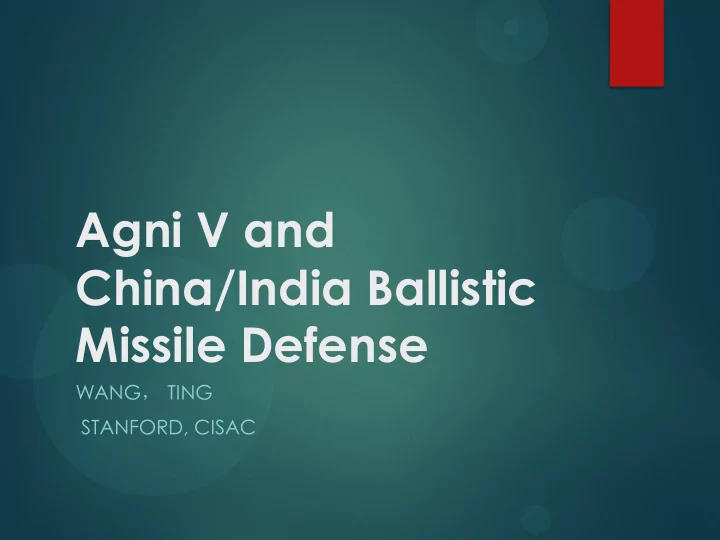

Agni V and China/India Ballistic Missile Defense WANG , TING STANFORD, CISAC
Agni-V missile Why did India develop Agni- V missile? Agni-V is the first India ICBM. Agni-V is not aim at China. Big country dream/ South Asia hegemony Does Agni V have Multiple Independently Reentry Vehicles (MIRV) capability? What will India do next?
Is Agni-V the first India ICBM ?
Polar Satellite Launch Vehicle (PSLV) is the first De facto India ICBM. Comparison between Russia China First generation ICBMs with PSLV Russia SS-6 CHN DF-4 ( LM 2) IND PSLV Mass 276 ton 183 ton 294 ton Payload 3.7 ton 3 ton 3 ton (5 ton) Range 12,000 km 12,000 km LEO In Service 1957 1981 1993
What is Agni V? It is the 3 rd Generation ICBM It is a Solid Fuel, Road Mobile Missile. It provides reliable “second strike” capability
Is it aim at China?
Agni III is launched in the North-East India.
What is 5,000 km range means?
Why did India develop Agni V? GDP Nuclear Weapons to offset Conventional Weapons
Why Chinese Media did not say so? “China is a threat” is political incorrect in China. In many Chinese subconscious, China is not a superpower / great power.
MIRV? Warhead Third Stage Second Stage First Stage Agni-III Agni-V
India missiles still have a lot to improve. Reliability Mass MIRVs Agni V does provide strategic nuclear deterrence against China. Nuclear Dialogue between China and India should be encouraged.
Missile Defense
Chinese Missile Defense China performed a mid-course missile defense in 2010. Missile Defense Test or ASAT Test? From technique viewpoint, Chinese Missile defense is unable to defend against US Missiles, but might be able to defend against India Missiles.
India Ballistic Missile Defense It was firstly designed to intercept Pakistan ballistic missiles. However, on 6 May 2012, Dr. V. K. Saraswat, the Director General of the Defense Research and Development Organization, said “Phase -II (of the missile defense) would be completed by 2016 to protect against missiles having range up to 5,000 km .”
Could the planned India missile defense really be able to defend against Chinese missiles?
Current India Missile Defense Swordfish RADAR ----Long Range Tracking Radar The Prithvi Air Defence (PAD) exo-atmospheric altitude of 80 km Advanced Air Defence (AAD) endo-atmosphere altitude of 30 km Terminal phase Missile Defense
The DRDO plans to upgrade the capacity of Swordfish Radar to 1,500 km by 2011. Developing AD-1 and AD-2 -- high speed interceptors.
Swordfish Radar The Swordfish Radar, derived from the Israel GreenPine Radar, is a L band Radar. L band Radar is not a imaging radar. It is unable to discriminate decoys.
Terminal phase missile Defense Can only protect several key locations. Decoys problem It is difficult to intercept ICBM warhead China may have maneuverable warhead
Does China really want to develop Missile Defense? Does India really need to develop Missile Defense against China? More Dialog is needed.
Recommend
More recommend